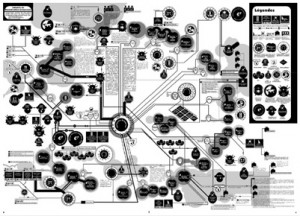 The American military network ARPAnet was conceived as a way to maintain uninterrupted communications in the event of nuclear war. Ancestor of the Internet and foundation of the Global Information Infrastructure, ARPAnet springs from exactly the same source as the “push-button war” that lay behind it: the change of scale provoked by the early 20th century discoveries in physics, within an industrial society capable of organizing the productivity – including the scientific productivity – of thousands of agents. Here, no doubt, is the real birthplace of the information society: a society massively penetrated by the sciences and technologies of information and telecommunications, using them to carry out the design of the planet or at least, that of its components (with design replacing politics). A society whose governmentality entails the knowledge of the real, that is to say, the transformation of reality into information. A society whose governmentality unfolds between its smallest common denominators (atomic, electronic, magnetic, genetic, chemical) and its largest common denominators (climate, planet, solar system), by way of laws, formulas and norms that determine its productivity, means, and possible destinies. (…)
The American military network ARPAnet was conceived as a way to maintain uninterrupted communications in the event of nuclear war. Ancestor of the Internet and foundation of the Global Information Infrastructure, ARPAnet springs from exactly the same source as the “push-button war” that lay behind it: the change of scale provoked by the early 20th century discoveries in physics, within an industrial society capable of organizing the productivity – including the scientific productivity – of thousands of agents. Here, no doubt, is the real birthplace of the information society: a society massively penetrated by the sciences and technologies of information and telecommunications, using them to carry out the design of the planet or at least, that of its components (with design replacing politics). A society whose governmentality entails the knowledge of the real, that is to say, the transformation of reality into information. A society whose governmentality unfolds between its smallest common denominators (atomic, electronic, magnetic, genetic, chemical) and its largest common denominators (climate, planet, solar system), by way of laws, formulas and norms that determine its productivity, means, and possible destinies. (…)
Map in english “governing by network”
Map in english “infocapital exchangers”
Text in english “governementality”
Texte in french “gouvernementalite”
 “First of all they’ve got to start by knowing how the system works… We can advise them on how they should put their argument on paper. We can advise them on which people in the committee would be interested… So that way you build a map for them, a sort of road map of where they need to go, who they need to talk to and what they need to know… We don’t do the lobbying… What we do is to give the company the information so that they can go and make the case for themselves.”
“First of all they’ve got to start by knowing how the system works… We can advise them on how they should put their argument on paper. We can advise them on which people in the committee would be interested… So that way you build a map for them, a sort of road map of where they need to go, who they need to talk to and what they need to know… We don’t do the lobbying… What we do is to give the company the information so that they can go and make the case for themselves.” Download map –
Download map –